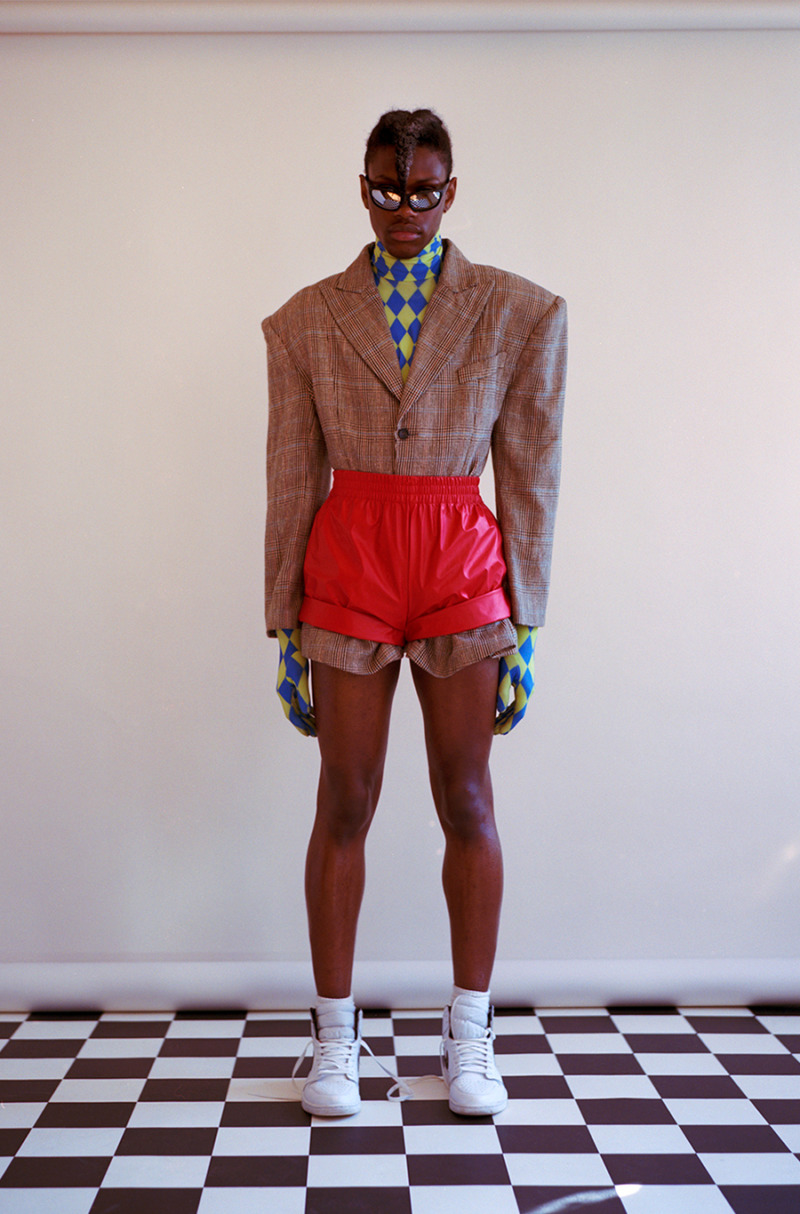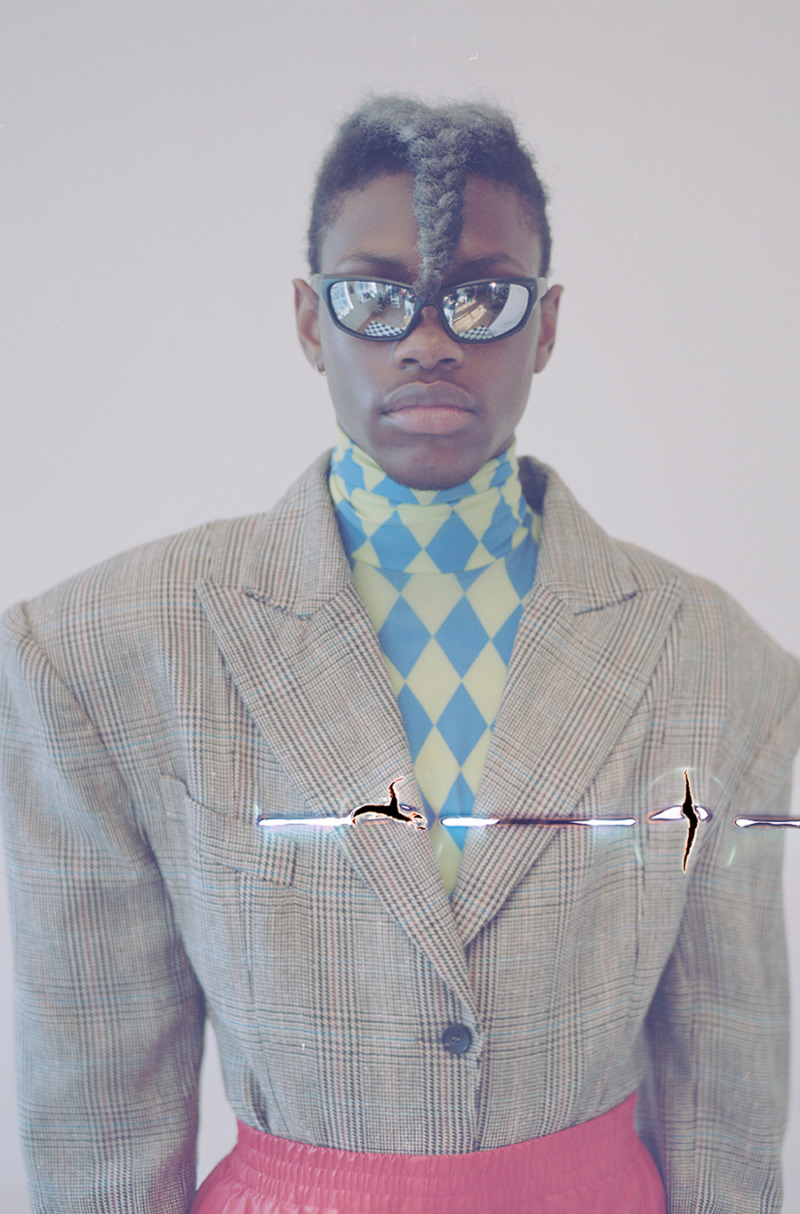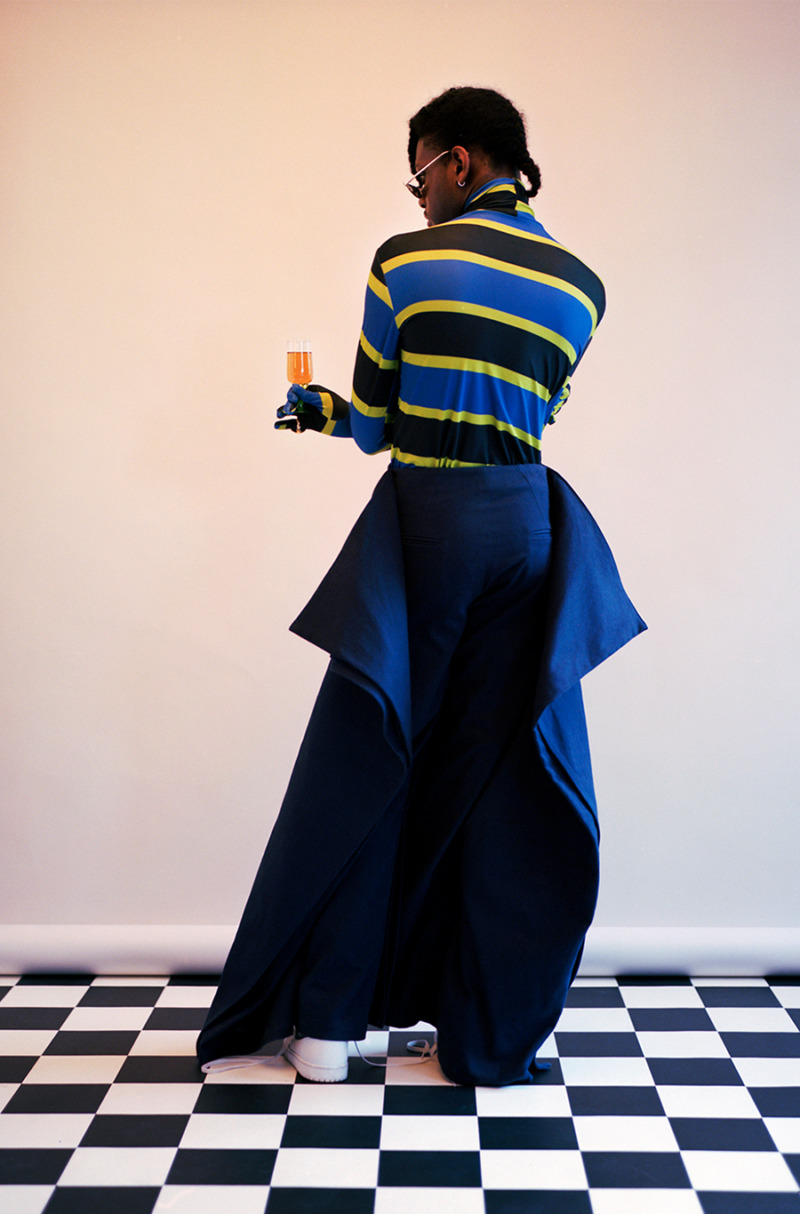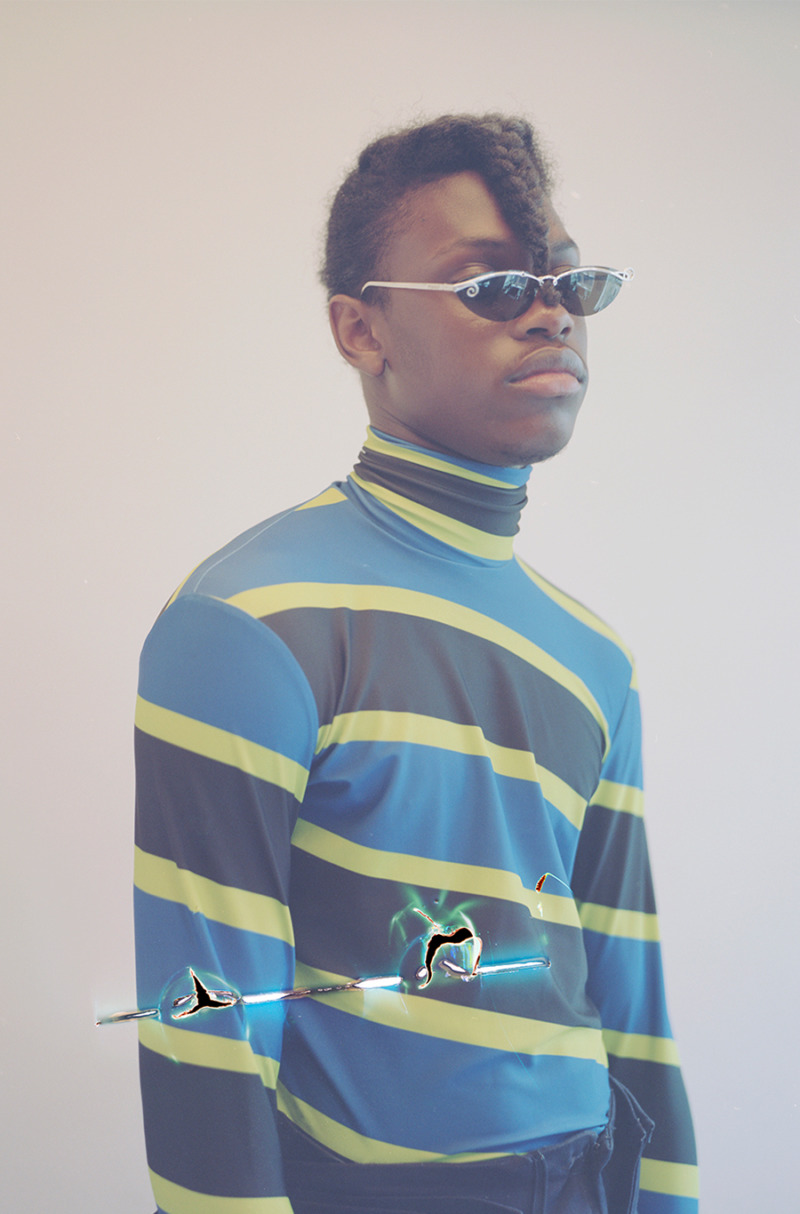Interview – GOOM

It’s true what they say: inspiration is all around us. If you look hard enough you might find it in the insouciant attitudes of Asian men who sport their pop bellies with pride in the dog days; in the stacked up rubbish piles that spill out onto the Korean pavements; or if you wake up early enough on a Sunday morning… In a British car boot sale!
Incongruous as it might sound, the medley of references – amongst other points of inspiration – create synergy in the work of South Korean-born and London-based menswear designer Goom Heo of GOOM, whose graduate collection, as she writes on Instagram, made for the material of memes. “It was so interesting to see how people behave differently on the streets in Korea or other Asian countries, and I started to notice the difference between Korea and western countries after living in London for a few years so I thought this could be an interesting starting point for my collection,” she tells us.
Divvying up equal attention to executing a ‘proper’ menswear collection through focusing on the finishing and patterns, while simultaneously offering a fusion of fun with unconventional elements, the collection poses the question ‘Why Not?’. “I always asked myself ‘why not?’ and ‘what is proper’ anyway?’ and it kind of gave me this idea for each look to embody a ‘why not’”, she explains on the name of the collection. “Why not have shorts on top of a tailored tracksuit or why not wear fishnet tights on top of trousers?”.
Her personal awareness of the cultural disparities between her remote upbringing and the urban landscape of London is at the core of her collection. And although some of her earlier work had touched on her heritage too (a previous project included creating prints influenced by the burgeoning trend of plastic surgery in her motherland; resulting in her fashioning a dress for Grayson Perry), she never planned on exploring her roots through her garments; rather, the route evolved organically. “The main reason I decided to start exploring Korean culture and style was that I was interested in the people in Korea and other Asian countries when I started to think of final collection,” she says. “It kind of came naturally during a gap year spent in Korea, as I was seeing and experiencing so many interesting things.”

Your trajectory through fashion school wasn’t straightforward. You decided to take time out before your placement year and to head back home to Korea to regather your thoughts. I’m interested to hear about this period and to find out how this shaped and changed your aesthetic and approach to fashion.
I wanted a break from fashion and what I was doing in London, so I went back to my hometown in Korea where there is nothing going on in fashion or art. It’s a very small town in a small city with lots of mountains and farms. It was nice to spend time with my family and friends and doing other things that I’ve always wanted to do which aren’t related to fashion or art, except for Korean traditional embroidery, which I was learning over a year in Korea. The break kind of gave me the idea that I’m interested in many things other than fashion, and fashion isn’t the only thing I want to do in my life, which also makes me be open to other stuff. And I think it’s very important to have this mindset for myself because it gives me more space to explore other creative possibilities. I’m interested in photography, art direction, music and styling, but then also creative possibilities in fashion means to bring these other interesting creative possibilities and create something new, not just focus on fashion itself.
Before your time out and your shift into menswear, you were studying womenswear; was there a clear focus on Korean culture in your early work? Has Korean culture always been at the forefront of your design process?
I don’t think I was always focused on Korean culture in my early work, although I did one project about Korean plastic surgery, which explored the concept of beauty in Korea and the increasing trend of having plastic surgery in Korea. I was interested in how some people end up looking similar after having plastic surgery in Korea, and I created prints inspired by this topic and made a dress for Grayson Perry.
My early work was focused on many other topics – it all depended on what I was interested in during that time: I did a project about fan girls in Las Vegas, art installations, stealing objects. The main reason why I decided to start exploring Korean culture and style was that I was interested in the people in Korea and other Asian countries when I started to think of my final collection. It was so interesting to see how people behave differently on the streets in Korea or other Asian countries, and I started to notice the difference between Korea and western countries after living in London for a few years, so I thought this could be an interesting starting point for my collection. It kind of came naturally during a gap year spent in Korea, as I was seeing and experiencing so many interesting things.
Can you paint a picture of what life is like in Korea: your hometown, partying, arts and culture scenes, and any similarities or crossovers to London life.
My hometown is a very small town surrounded by lots of mountains and farms, it’s quite far from the city and most people are farmers and do not work in anything related to fashion or art. There’s no museums or galleries, or even a movie theatre in my town, we need to drive about 30 minutes to go to the cinema. So when I was living there, it was very hard to experience different cultures and art but there was definitely a culture in my hometown which I think people from outside probably find interesting when they visit. When I lived in Seoul for a year before I came to London, there was definitely more fashion, art, and culture going on. Nightlife in Korea is insane, everywhere is opened until morning, there are lots of 24-hour cafes where you can go to chat or work with your friends, and you can always have fun even though it’s super late. There are no restrictions; you will find somewhere whenever and wherever in Seoul. I think this is quite similar to London as you will find somewhere interesting in London wherever you are, each area has a different vibe but still, you will find it interesting, whether it’s fun or not.
Your time observing in Korea also informed one of your standout pieces from your grad collection which garnered a lot of interest: the piled shirts made to resemble the piles of rubbish you saw on the streets. How did you get from piled rubbish to piled shirts?
My work is all related to my research and some of them are very straightforward that you can see it obviously from my research. I just wanted to translate that image into one of the garments in my collection; I was thinking why not wear piles of the t-shirts all at the same time? I thought this could be a new way to show my print idea as well by manipulating fabrics (t-shirts) altogether. So it makes one whole print by using different colour fabrics and t-shirts.

You’ve said you get most of your inspiration from the streets – from what you see and collect; has studying and living in London informed your aesthetic?
I think living and studying in London made me be more myself; be more honest with what I like and what I want to do with my work and also myself as well. It doesn’t matter about the areas in London, it’s more wherever I go when I see or find something interesting that inspires me. I go to lots of car boot sales and charity shops to collect things for my research. For my BA collection, most of the inspiration was from the streets in Korea. And I still get lots of inspiration when I’m back home, whether it’s in my hometown or a big city like Seoul, I always find something interesting that I never thought could be my research when I was living in Korea. I guess it kind of gave me a different perspective after living in London for a few years.
Talk me through all of the cultural characteristics and references in your collection and the significance of including them.
The starting point of my collection was when I saw Asian guys with their t-shirts rolled up in the summer, showing their fat bellies with no shame. I thought this was really cool. It was something different from what I’ve seen or experienced in western culture. Even though I grew up in South Korea until I was 18 years old, I felt different seeing those people after living abroad for 6 years. The stuff I find interesting on the streets in Korea, such as piles of cardboard boxes and messy posters on the wall, these were also part of my research to develop my textile ideas.
A major motivation of my work is to reinterpret my personal awareness of cultural differences I have experienced in Western and Asian countries, with a particular focus on how the cultural characteristics are visually translated into clothing. I find that back home, where I’m from, people have their own style which some people might think is funny or not stylish, but I wanted to tell people who see my collection that these people have their own unique style and this also can be a cool thing, something that people want to wear as well.
I think most people have their own styles and do not follow trends or what’s going on in the fashion industry and even if they do, they still have their own unique style. And I feel like they are more appreciative of vintage in the UK. There’s more vintage culture now in Korea, but still, people prefer to wear new clothes and follow the trends in fashion. But the good thing is there are people who dress up to express themselves, which makes it more unique and interesting.
What do you think are the biggest disparities between how the west view Korean and Asian fashion and how you think it really is and do you hope to perhaps challenge certain stereotypes of Asian culture that exist in the west?
I think the fashion industry in Korea is getting bigger and people from western countries are more interested in Korean, or Seoul fashion week, which I think is amazing and I’m very happy that some Korean designers bring their shows to London, Paris or New York. This gives more opportunity to people in western countries to see and experience Korean fashion, which I think is great. Most people in western countries probably have a different view towards Asian and Korean fashion, but I think most of them think that Asian or Korean fashion industries are following the trends from western countries. But actually, there are some Korean designers who are very creative and talented and also authentic, where they show Korean culture and sensibility through their collection. I hope there are more opportunities for these Korean designers to expose themselves more in western countries so people can see what Korean fashion is like.
You’re on the MA fashion course at CSM now, is your Korean heritage something you plan to continue referencing and exploring in your future collections?
I don’t think I will always reference Korean heritage with my work and my future collection as I’m interested in many other things and would like to explore different topics as well. It’s something that came naturally from myself as I have spent most of my life in Korea, and I put references to my work and research from my experience; what I saw, what I liked from Korea or any other Asian country. But I’m sure it will affect me in everything I do in the future, even though it may not be necessarily about Korean culture.

Photographer: Ed Phillips
Stylist: Shirley Amartey
Stylist Assistant: Aayushi Vasant
Grooming: Emma Small
Hair: Afi Emily Attipoe
Model: Abolaji @Anti-Agency
